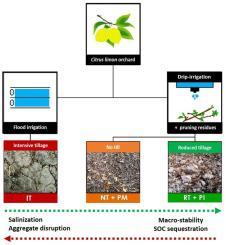Soil and Tillage Research ( IF 6.1 ) Pub Date : 2021-07-14 , DOI: 10.1016/j.still.2021.105129 Noelia Garcia-Franco 1 , Martin Wiesmeier 1, 2 , Luis Carlos Colocho Hurtarte 1, 3 , Franziska Fella 1 , María Martínez-Mena 4 , María Almagro 4 , Eloisa García Martínez 4 , Ingrid Kögel-Knabner 1, 5

|
Soil salinization is an emerging problem worldwide as a result of unsustainable land management practices and climate change. However, salt-affected soils under agricultural use could act as a C sink if these negative effects can be offset by combination of sustainable land management practices (SLM). In this study, we assessed the effect of (i) intensive tillage along with flood irrigation (IT); (ii) combination of no-tillage with pruning residues (branches and leaves) as mulch, and drip-irrigation (NT + PM); and (iii) combination of reduced tillage with the incorporation of pruning residues and drip-irrigation (RT + PI), on physico-chemical soil parameters, aggregate stability, amount and quality of organic matter fractions and soil organic carbon (SOC) sequestration in a lemon tree orchards (Citrus limon var. Verna) under semi-arid climate conditions. The RT + PI management system showed a decrease in salinity and bulk density, and increased soil porosity, soil OC and N stocks, and percentage of OC-rich macroaggregates as compared to the IT system. The aggregate-occluded particulate organic matter fraction (oPOM) played a key role in macroaggregate stability. The NT + PM treatment also showed positive effects on the investigated soil properties, but this was limited to the upmost topsoil (0−5 cm). The IT management system revealed highest values of salinity and bulk density, and considerably lower SOC stocks. Moreover, a degradation of soil structure with a low percentage of macroaggregates depleted in SOC was observed. We conclude that the incorporation of pruning residues in combination with reduced tillage and drip-irrigation is an effective management system to improve soil structure and facilitate SOC sequestration. Therefore, conventional management systems based on intensive tillage and flood irrigation should be abandoned in salt-affected soils under semi-arid climate conditions in favour of systems with higher organic matter inputs incorporated into the soil combined with measures to reduce the salt content.
中文翻译:

修剪残留物掺入和减少耕作改善半干旱柑橘树果园受盐影响土壤的土壤有机质稳定性和结构
由于不可持续的土地管理做法和气候变化,土壤盐渍化是世界范围内一个新出现的问题。然而,如果这些负面影响可以通过可持续土地管理实践 (SLM) 的组合来抵消,那么农业用途下受盐影响的土壤可以充当碳汇。在这项研究中,我们评估了 (i) 集约化耕作和漫灌 (IT) 的效果;(ii) 免耕与修剪残留物(树枝和树叶)作为覆盖物和滴灌(NT + PM)相结合;(iii) 减少耕作结合修剪残留物和滴灌 (RT + PI),对土壤理化参数、团聚体稳定性、有机质部分的数量和质量以及土壤有机碳 (SOC) 封存的影响柠檬树果园(柑橘柠檬变种 维尔娜) 在半干旱气候条件下。与 IT 系统相比,RT + PI 管理系统显示盐度和容重降低,土壤孔隙度、土壤 OC 和 N 储量以及富含 OC 的大团聚体百分比增加。聚集体吸留的颗粒有机物分数 (oPOM) 在大聚集体稳定性中起着关键作用。NT + PM 处理也对所研究的土壤特性显示出积极影响,但这仅限于最上层的表土(0-5 厘米)。IT 管理系统显示盐度和堆积密度的最高值,以及显着降低的 SOC 储量。此外,观察到土壤结构退化,SOC 中消耗的大团聚体百分比较低。我们得出结论,修剪残留物与减少耕作和滴灌相结合是改善土壤结构和促进 SOC 封存的有效管理系统。因此,在半干旱气候条件下,在受盐分影响的土壤中,应放弃基于集约化耕作和漫灌的传统管理系统,转而采用向土壤中加入更多有机质并结合降低盐分的措施的系统。











































 京公网安备 11010802027423号
京公网安备 11010802027423号